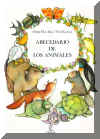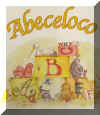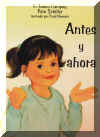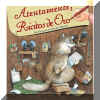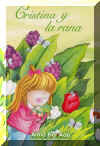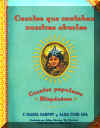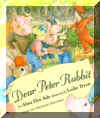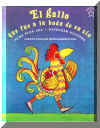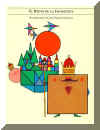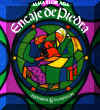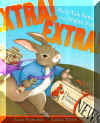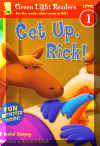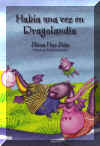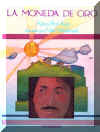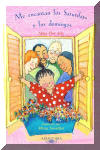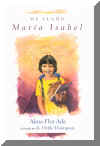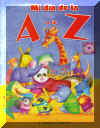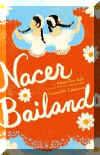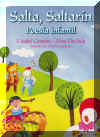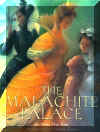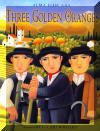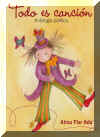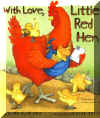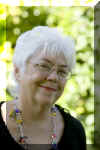 Author : Alma Flor Ada,
Gabriel Zubizarreta
Author : Alma Flor Ada,
Gabriel Zubizarreta3rd Grade and Up
 Author : Alma Flor Ada,
Gabriel Zubizarreta
Author : Alma Flor Ada,
Gabriel Zubizarreta
3rd Grade and Up
Nacer Bailando
Dancing Home
 Nacer
Bailando, Hardcover, Spanish, Book, Alma Flor Ada,
Gabriel Zubizarreta, 3rd Grade and Up, 9781442420618, $14.99 Watch
Nacer
Bailando, Hardcover, Spanish, Book, Alma Flor Ada,
Gabriel Zubizarreta, 3rd Grade and Up, 9781442420618, $14.99 Watch
Dancing Home,
Hardcover, English,, Book, Alma Flor Ada,
Gabriel Zubizarreta, 3rd Grade and Up, 9781416900887, $14.99 Watch
$277.52 for the Story Collection Green Books and CDs Spanish Set, Including 20%-Off, Free Shipping, and No Sales Tax : 1 Hardcover Spanish Book, 15 Softcover Spanish Books, 2 Softcover Spanish Oversized Books, 1 Spanish Big Book, 2 Spanish Storytelling CDs, 1 Bilingual Storytelling CD, and 1 Spanish Music CD
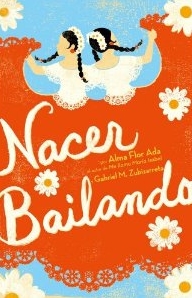 A year of
discoveries culminates in a performance full of surprises, as two girls find
their own way to belong. Mexico
may be her parents’ home, but it’s certainly not Margie’s. She has finally
convinced the other kids at school she is one-hundred percent American—just
like them. But when her Mexican cousin Lupe visits, the image she’s created
for herself crumbles. Things aren’t easy for Lupe, either. Mexico
hadn’t felt like home since her father went North to find work. Lupe’s hope
of seeing him in the United States comforts her some, but learning a new
language in a new school is tough. Lupe, as much as Margie, is in need of a
friend. Little by little, the girls’ individual steps find the rhythm of
one shared dance, and they learn what “home” really means. In the tradition
of My Name is Maria Isabel—and simultaneously published in English and in
Spanish—Alma Flor Ada and her son Gabriel M. Zubizarreta offer an honest story
of family, friendship, and the classic immigrant experience: becoming part of
something new, while straying true to who you are.
A year of
discoveries culminates in a performance full of surprises, as two girls find
their own way to belong. Mexico
may be her parents’ home, but it’s certainly not Margie’s. She has finally
convinced the other kids at school she is one-hundred percent American—just
like them. But when her Mexican cousin Lupe visits, the image she’s created
for herself crumbles. Things aren’t easy for Lupe, either. Mexico
hadn’t felt like home since her father went North to find work. Lupe’s hope
of seeing him in the United States comforts her some, but learning a new
language in a new school is tough. Lupe, as much as Margie, is in need of a
friend. Little by little, the girls’ individual steps find the rhythm of
one shared dance, and they learn what “home” really means. In the tradition
of My Name is Maria Isabel—and simultaneously published in English and in
Spanish—Alma Flor Ada and her son Gabriel M. Zubizarreta offer an honest story
of family, friendship, and the classic immigrant experience: becoming part of
something new, while straying true to who you are.
Kirkus Reviews : Two cousins, one born in Texas and the other in Mexico, learn the importanceof family and friendship. As an only child living in California with her Mexican-American parents, Margie Ceballos-González is proud to be American. Everything changes when her cousin Lupe González leaves her mother, stepfather and half-brothers in Mexico to live with Margie and her parents. Years before, Lupe’s father had moved to the United States for work and then disappeared. Margie and Lupe areboth in fifth grade at the same school, and Lupe’s presence immediately draws exactly the sort of attention Margie has been trying to avoid. At home, she finds herself competing for attention as her parents welcome Lupe with Mexican foods and Spanish conversation. Sensing her cousin’s dilemma, Lupe finds ways to help Margie appreciate their shared Mexican heritage. Margie thaws, even realizing the beauty of her name, Margarita, which came from one ofher mother’s favorite flowers, the daisy. The third-person narration shifts its focus gently from girl to girl, allowing readers access to their thoughts and feelings. The authors also connect Nicaraguan poet Rubén Darío’s“A Margarita” to the story, and the full poem follows the novel inboth Spanish and English. Although sometimes wise beyond their years, Margie and Lupe will charm readers as each girl struggles for belonging and acceptance in this realistic novel. (Fiction. 8-12)
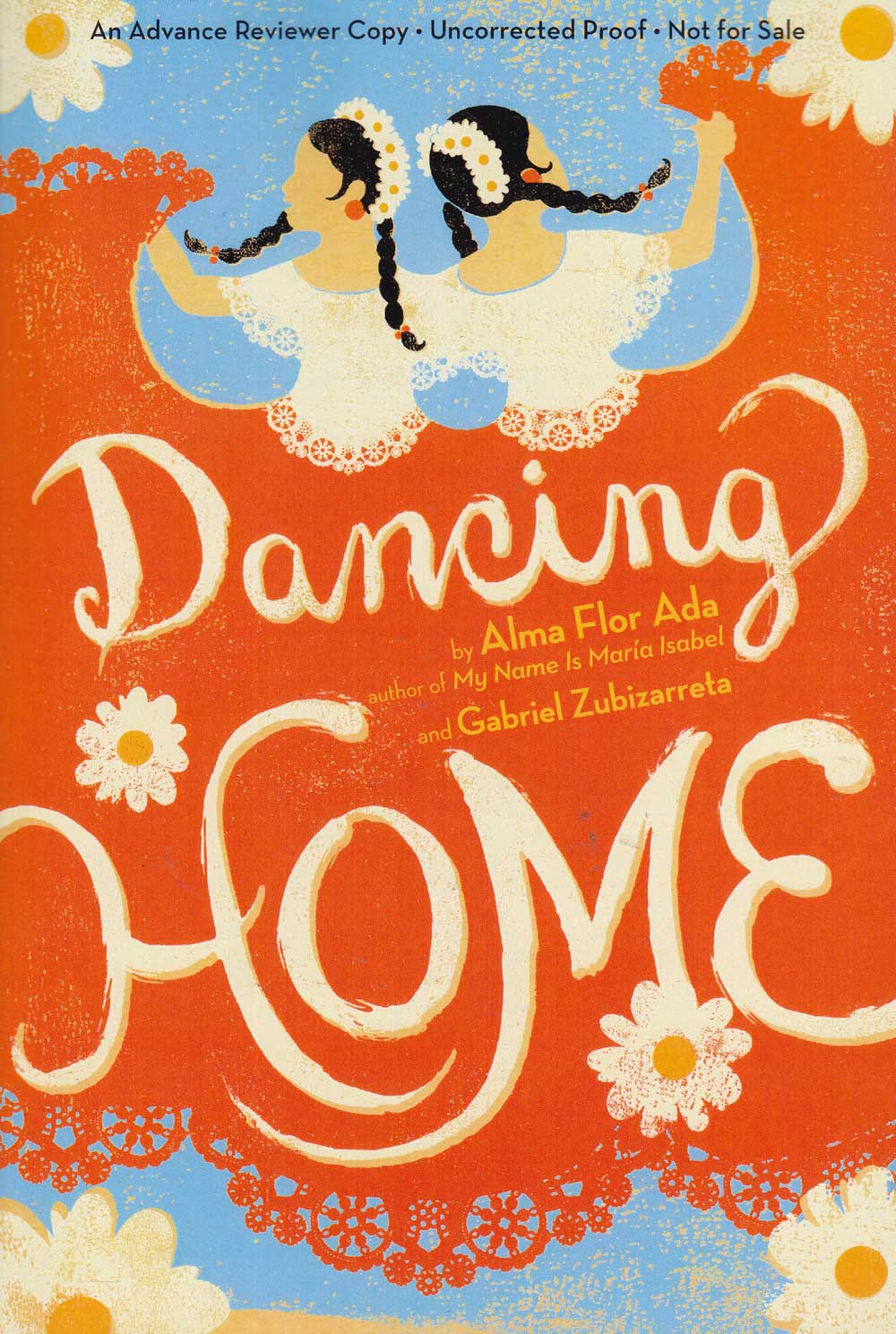 School Library
Journal : Gr 3-6–Margie is proud to be an American, born in the United States. Her parents were born in Mexico and so was
her cousin, Lupe, who has come to stay with Margie’s family in California. At
first Margie is excited, but that enthusiasm dissipates when Lupe is placed in
her classroom. She doesn’t speak English, and Margie’s teacher expects her
to translate for her. A couple of classroom bullies seem bent on belittling the
cousins’ heritage. Margie is relieved when Lupe is transferred to a bilingual
class, leaving a desk near her for the newest classmate, Camille. The girlsbecome great friends. When they’re given a journal assignment, Camille
models what it’s like to have a passion as she thinks, researches, and writes
about dolphins. Lupe stays after school to learn folkloric dances, and the book
concludes with a performance that helps Margie understand how American she isand how her Mexican heritage fits into her identity. This story will
assist readers in embracing their own heritage and developing an appreciation fortheir classmates’ backgrounds. It’s an enjoyable offering (and a
great read-aloud) that will capture readers’ attention and have them rooting for
the cousins and their friendships and family relationships. A Spanish-language
edition, Nacer Bailando, is available simultaneously.
School Library
Journal : Gr 3-6–Margie is proud to be an American, born in the United States. Her parents were born in Mexico and so was
her cousin, Lupe, who has come to stay with Margie’s family in California. At
first Margie is excited, but that enthusiasm dissipates when Lupe is placed in
her classroom. She doesn’t speak English, and Margie’s teacher expects her
to translate for her. A couple of classroom bullies seem bent on belittling the
cousins’ heritage. Margie is relieved when Lupe is transferred to a bilingual
class, leaving a desk near her for the newest classmate, Camille. The girlsbecome great friends. When they’re given a journal assignment, Camille
models what it’s like to have a passion as she thinks, researches, and writes
about dolphins. Lupe stays after school to learn folkloric dances, and the book
concludes with a performance that helps Margie understand how American she isand how her Mexican heritage fits into her identity. This story will
assist readers in embracing their own heritage and developing an appreciation fortheir classmates’ backgrounds. It’s an enjoyable offering (and a
great read-aloud) that will capture readers’ attention and have them rooting for
the cousins and their friendships and family relationships. A Spanish-language
edition, Nacer Bailando, is available simultaneously.
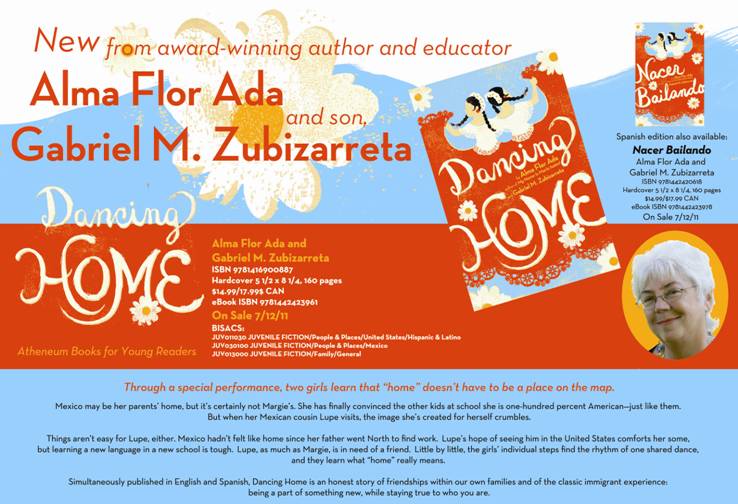 Booklist
: Ten-year-old Margie has spent her entire life trying to fit in—to pass as anAmerican—despite the fact that her parents were born in Mexico. Then, herMexican cousin Lupe comes to live with them, and her plan
goes awry. At first, she resents Lupe for her foreign ways and for monopolizingher parents’ attention; later, she comes to love Lupe as a sister andappreciate the Mexican part of her heritage. Margie begins to
master Spanish, enjoys celebrating Navidad, and participates in a Cinco de Mayofolklorico dance at school. Ada, the author of many multicultural titles,including Tales Our Abuelitas Told: A Hispanic
Folktale Collection (2006), and Zubizarreta write knowingly of the difficulties
of a life lived in two cultures. A subplot involving Lupe’s father (who came
to America illegally and later abandoned his family) is also well handled, as is the inclusion of a Ruben Dario poem,“To Margarita.” Give this to fans of Pam Muñoz Ryan’s Esperanza Rising (2000)and Becoming Naomi Leon (2004).
Booklist
: Ten-year-old Margie has spent her entire life trying to fit in—to pass as anAmerican—despite the fact that her parents were born in Mexico. Then, herMexican cousin Lupe comes to live with them, and her plan
goes awry. At first, she resents Lupe for her foreign ways and for monopolizingher parents’ attention; later, she comes to love Lupe as a sister andappreciate the Mexican part of her heritage. Margie begins to
master Spanish, enjoys celebrating Navidad, and participates in a Cinco de Mayofolklorico dance at school. Ada, the author of many multicultural titles,including Tales Our Abuelitas Told: A Hispanic
Folktale Collection (2006), and Zubizarreta write knowingly of the difficulties
of a life lived in two cultures. A subplot involving Lupe’s father (who came
to America illegally and later abandoned his family) is also well handled, as is the inclusion of a Ruben Dario poem,“To Margarita.” Give this to fans of Pam Muñoz Ryan’s Esperanza Rising (2000)and Becoming Naomi Leon (2004).
New York Times : Bilingualism and biculturalism are central to “Dancing Home,” by Alma Flor Ada and Gabriel M. Zubizarreta, which is being published in both English and Spanish, and tells the story of a fifth grader, Margie, Texas-born, California-reared and determined to be American at any cost. Her assimilation is challenged when her mother, Consuelo, obtains a visa for Lupe, Margie’s cousin from Mexico. Lupe, also in fifth grade, is a math whiz, but she doesn’t speak English, and everything about her embarrasses Margie, who is less than welcoming. Lupe is the daughter of Consuelo’s brother, an illegal immigrant who has disappeared. “Dancing Home” doesn’t shy from any of the harsher truths about life for Mexican immigrants: Consuelo tells Lupe that her father may be in debt to coyotes who help people cross the border illegally for a great price. His silence may be the result of his living in difficult circumstances. In the classroom, the taunts that Margie fears about immigrants are spoken without hesitation even as Ada and Zubizarreta — who are mother and son — make clear that Margie’s parents came to the United States legally and that Lupe can travel safely with a student visa. But it is the friendship between the girls and the tall, blond Camille (also a secret Latina at large) that makes this an absorbing novel for readers of any background. And the authors, for the most part, handle the narrative with tenderness and charm. As Camille tells Margie: “My father says all the time, ‘What’s important is what you learn after you already think that you know everything.’ ”
New Book Journal : In Dancing Home, two cousins, one born in Texas and the other in Mexico, learn the importance of family and friendship. As an only child living in California with her Mexican-American parents, Margie Ceballos-González is proud to be American. Everything changes when her cousin Lupe González leaves her mother, stepfather and half-brothers in Mexico to live with Margie and her parents. Years before, Lupe’s father had moved to the United States for work and then disappeared. Margie and Lupe are both in fifth grade at the same school, and Lupe’s presence immediately draws exactly the sort of attention Margie has been trying to avoid. At home, she finds herself competing for attention as her parents welcome Lupe with Mexican foods and Spanish conversation. Sensing her cousin’s dilemma, Lupe finds ways to help Margie appreciate their shared Mexican heritage. Margie thaws, even realizing the beauty of her name, Margarita, which came from one of her mother’s favorite flowers, the daisy. The third-person narration shifts its focus gently from girl to girl, allowing readers access to their thoughts and feelings. The authors also connect Nicaraguan poet Rubén Darío’s “A Margarita” to the story, and the full poem follows the novel in both Spanish and English. Although sometimes wise beyond their years, Margie and Lupe will charm readers as each girl struggles for belonging and acceptance in this realistic novel. (Fiction. 8-12)
Story
Collection Green Books and CDs
:
